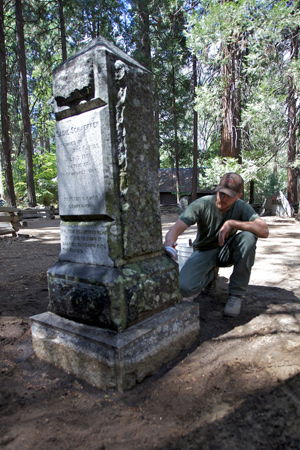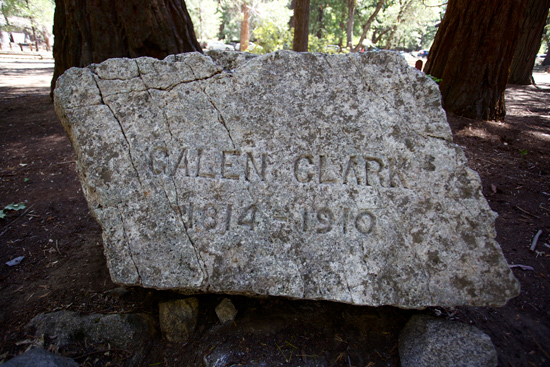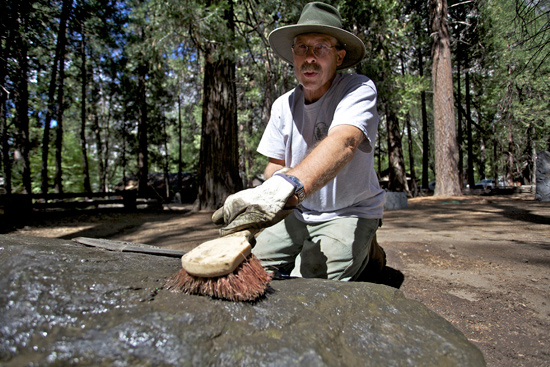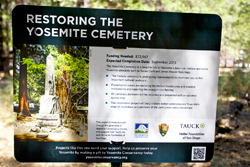
John Venn cleans lichens and mosses from the headstone of Sadie Schaeffer, a local waitress who drowned in the Merced River in 1901.
Beneath a large uncut granite stone with the inscription, BUILDER OF THE FIRST TRAILS, ROADS, BRIDGES AND DWELLINGS OF THIS VALLEY, lie the bones of James Mason Hutchings. It was Hutchings who organized the first tourist party to enter Yosemite Valley in 1855. Among the four people in that party was an artist named Thomas Ayres who drew sketches of Yosemite Valley and its various features. Hutchings featured them as etchings in his Hutchings California Magazine. James Hutchings actively promoted Yosemite Valley as a tourist destination and would later purchase a hotel in the valley.

In the shade of four giant sequoias sits another natural granite boulder with the name, Galen Clark, carved in it. Clark was among another tourist group that entered Yosemite Valley in 1855. His visit had so profound an effect on him that upon learning that he had a serious case of consumption (his wife had died of consumption a few years earlier) he decided to live out his remaining time in the mountains near Yosemite. He was in his early forties at the time and in the short time he had left on this earth he would play a major role in the setting aside and development of the Mariposa Grove and Yosemite Valley.
Galen Clark located and named the Mariposa Grove; worked for the creation of the Yosemite Grant, an act that that included the protection of the Mariposa Grove and Yosemite Valley; became the first guardian of the grant; guided many parties throughout his beloved big trees and valley; wrote books about the Yosemite Grant, the big trees, and Indians of Yosemite. During this time, he selected the site for and dug his own grave. He also chose the boulder for his headstone, had his name carved in it, and planted the giant sequoias that surround his plot. Clark accomplished so much because his short life became very long. He died, not in his forties but a few days before his 96th birthday!
Many other headstones mark the last resting places of all sorts of people from the early days in Yosemite’s history. There are people who died here while on vacation, early settlers and homesteaders, old timers and infants, hotel proprietors and common laborers, each with a story. Many of these stories are entwined like strands in a rope that spans a century or more. Some stories are short and alone. Some, like those of American Indians buried here are so hidden we may never know them.
Over the years the markers and monuments in the Yosemite Cemetery, have faded with neglect. And with them the brilliance of the echoes and stories that keep the memory of Yosemite’s forbearers alive. Gravestones were damaged and split. Metal fences were broken. Weathering and vegetation stains obscured the names and details of our past. Something had to be done.

Jeff Swanstrum scrubs the marker stone of Forest Townsley, Chief Ranger in Yosemite from 1916 until his death in 1943.
With a grant through Yosemite Conservancy, stabilization and repairs are underway. Seventeen marble and granite monuments have been scrubbed to remove staining, lichens, and mosses. The twenty-foot tall monument to homesteader James Lamon and its associated chain fence and pillars are being repaired and leveled. The National Park Service is also refurbishing wooden grave markers. Soon workers will repair two metal fences surrounding other graves. In the fall volunteers will remove seedlings, clean debris from graves and walls, and dismantle the wood fence while better delineating walking paths through the cemetery. The National Park Service is consulting with tribes and tribal groups to learn of their desires for the American Indian gravesites.


It you would like to visit the Yosemite Cemetery, begin by picking up a copy of the Guide to the Yosemite Cemetery at the Yosemite Valley Visitor Center. From the front of the visitor center, walk west past the museum building and then cross the street. The entrance to the Yosemite Cemetery will be directly in front of you. Wander among the monuments and markers, read the stories in the booklet, let yourself be transported back in time, and listen to the echoes of Yosemite’s past.
Learn more about James Hutchings and Galen Clark along with other interesting tidbits about Yosemite's past.
